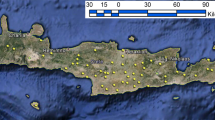Abstract
Several alternative estimation and interpolation methods for making annual precipitation maps of Asturias are analysed. The data series in this study corresponds to the year 2003. There exists an evident relationship between precipitation and altitude, with a high correlation coefficient of 0.70, that reflects the hillside effect; that is, the increase in the amount of precipitation in more mountainous areas. The direct spatial variability of precipitation and of altitude and the cross variability of precipitation–altitude are defined by two exponential variogram models: one with a short-range structure (15–30 km) that reflects the control exerted by the lesser, local mountain ranges over the amount of precipitation; and another with a long-range structure (80 km) that supposes the influence over precipitation of the major mountainous alignments of the inland areas of the Cantabrian Mountain Range (Cordillera Cantábrica) situated between 60 and 90 km from the coastline. These variogram models had to be validated for coregionalization by the Pardo-Igúzquiza and Dowd method so as to be able to make the cokriging map. The geometric estimation methods employed were triangulation and inverse distance. The geostatistical estimation methods developed were simple kriging, ordinary kriging, kriging with a trend model (universal kriging), lognormal kriging, and cokriging. In all of these methods, a 3 × 3 km2 grid was selected with a total of 2580 points to estimate, a circular search window of 60 km, and a relatively small number of samples with the aim of highlighting the local features and variations on isohyet maps. The kriging methods were implemented using the WinGslib software, incorporating two specific programs, Prog2 and Fichsurf, so as to be able then to make isohyet maps using the Surfer software. All the methods employed, apart from triangulation, rendered realistic maps with good fits to the values of the original data (precipitation) of the sample maps. The problem with triangulation lies not in the reliability of the estimates but in the fact that it gives rise to contrived maps because of the tendency of isohyets to present abundant triangular facets. The reliability of the methods was based on cross-validation analysis and on evaluation of the different types of errors, both in their values and in their graphical representations. Substantial differences were not found in the values of the errors that might discriminate some methods from others in an evident way. Bearing the aforesaid in mind, should we have to make an evaluation of the different estimation methods in decreasing order of acceptance, this would be: kriging with a trend model, inverse distance, cokriging, lognormal kriging, ordinary kriging, simple kriging, and triangulation. The application of other estimation methods such as colocated cokriging, kriging with an external drift, and kriging of variable local means (residual kriging) is dependent on the availability of a digital model of the terrain with an altitude grid of the region.












Similar content being viewed by others
References
Goovaerts P. (1997) Geostatistics for natural resources evaluation: Oxford Univ. Press, Oxford, p. 483
Isaaks E. H., Srivastava R. M. (1989) An introduction to applied geostatistics. Oxford Univ. Press, Oxford, p. 561
Pardo-Igúzquiza E., Dowd P.A. (2002) FACTOR2D: a computer program for factorial cokriging. Computers & Geosciences 28(8):857–875
Rockware, 2002, (Earth Science&GIS Software): Surfer for Windows, user’s guide, http://www.rockware.com
WinGslib, 2001, WinGslib installation and getting started guide: Statios LLC, http://www.statios.com
Acknowledgment
Our grateful acknowledgement to the University of Oviedo for funding under the Proyecto de Investigación científico-cultural de interés regional: “Análisis estadístico y geostadístico de las precipitaciones anuales de Asturias,” reference MC1-03-515-2.
Author information
Authors and Affiliations
Corresponding author
Rights and permissions
About this article
Cite this article
Fernández, C., Bravo, J. Evaluation of Diverse Geometric and Geostatistical Estimation Methods Applied to Annual Precipitation in Asturias (NW Spain). Nat Resour Res 16, 209–218 (2007). https://doi.org/10.1007/s11053-007-9053-6
Received:
Accepted:
Published:
Issue Date:
DOI: https://doi.org/10.1007/s11053-007-9053-6




